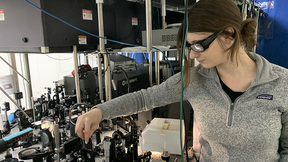LLNL finds a place in the sun
This year marks five years in space for NASA's Solar Dynamics Observatory (SDO), which provides incredibly detailed images of the whole sun 24 hours a day.
Capturing an image with one arcsecond spatial resolution at 10 different wavelengths once per 10 seconds, SDO has provided an unprecedentedly clear picture of how massive explosions on the sun grow and erupt ever since its launch on Feb. 11, 2010. The imagery allows observers to watch the constant movement of solar material through the sun’s atmosphere, the corona.
Lawrence Livermore has played a large role in the development of the imaging optics aboard the SDO. Led by Regina Soufli in the Lab’s Physics Division, the team, made up of Jeff Robinson, Eberhard Spiller, Sherry Baker and Jay Ayers as well as collaborators from Lawrence Berkeley Lab and other institutions, have been instrumental in the design, development, fabrication and calibration of the multilayer mirrors aboard the SDO imaging telescopes. The SDO multilayer mirrors act as reflective lenses and are responsible for capturing the images and movies of the sun produced by SDO at seven extreme ultraviolet (EUV) wavelengths.
Soufli also works with other SDO scientists on continuing improvements of the photometric calibration of the SDO imaging instrument and was co-recipient in 2012 of NASA’s Group Achievement Award, granted to SDO’s Science Investigation Team.
In honor of SDO's fifth anniversary, NASA has released a video showcasing highlights from the last five years of sun watching. See giant clouds of solar material hurled out into space, the dance of giant loops hovering in the corona and huge sunspots growing and shrinking on the sun's surface.
By imaging the sun at specific EUV emission lines from the solar plasma, the SDO telescopes record solar activity in exquisite spatial, spectral and temporal resolution for the purpose of studying and elucidating the sun’s extremely complex and dynamic magnetic field, its plasma and related phenomena.
By watching the sun in different wavelengths — and therefore different temperatures — scientists can watch how material and magnetic fields evolve through the corona, which holds clues to what causes eruptions on the sun, what heats the sun’s atmosphere up to 1,000 times hotter than its surface and why the sun’s magnetic fields are constantly on the move.
SDO has contributed to several groundbreaking discoveries, including solar flares and super-high-speed solar waves. It also has enabled modeling efforts to predict solar activity, including extreme events, such as solar flares which are bursts of EUV/X-ray light, energy and particles. Solar flares can occur by themselves or can be accompanied by coronal mass ejections, in which a giant cloud of solar material erupts off the sun, achieves escape velocity and heads off into space. When directed toward Earth, solar flares and coronal mass ejections can disrupt satellite communications and electricity grids and may pose threats to aviation and astronaut safety.
Contact
 Anne M. Stark
Anne M. Stark
[email protected]
(925) 422-9799
Related Links
LLNL multilayer mirrors fly on NASA’s Solar Dynamics ObservatoryLab scientist receives NASA award for the Solar Dynamics Observatory mission
NASA Solar Dynamics Observatory
Solar Dynamics Observatory video
Tags
ScienceFeatured Articles







